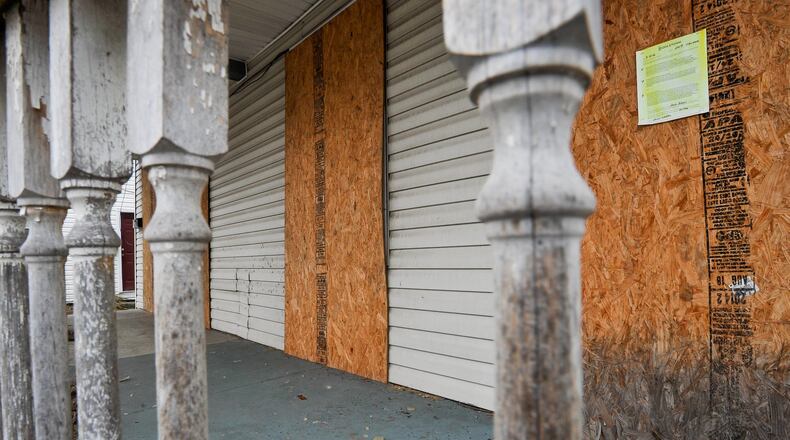But moving forward, lenders will be required to use alternative boarding materials, such as a glass-like polycarbonate that is easier on the eye and does not advertise that a home or building is unoccupied, supporters said.
House Bill 463, which was signed by Gov. John Kasich in the waning days of the last General Assembly in late December, is still being reviewed by some city officials to determine how it will impact their communities.
“We recently became aware of the new law but have not had sufficient time to review it and develop a plan on how to deal with it. Fortunately we do not have to deal with this issue very much in our community,” said Greg Kathman, Fairfield’s development services director.
Middletown City Manager Doug Adkins said the city has just started looking at the new law this week.
“We are still thinking through the ramifications and possible additional costs, Adkins said. “We have no beginning plans discussed yet to address this.”
As Middletown reviews the new law, officials believe there may be alternative materials that they could use.
“If we are required to use materials such as clear polycarbonate windows, it would significantly increase the costs of boarding up vacant properties,” said Kyle Fuchs, community revitalization director. “A sheet of plywood can be purchased for around $20 while I believe the polycarbonate runs around $120. Depending on the brand and product, the benefits of using clear boards typically is that since it looks like glass, it doesn’t advertise vacancy.”
Fuchs also said the clear boards are usually very difficult to be broken and not easily removed so it could prevent re-boarding a property multiple times as well as help keep vandals, criminals, and thieves away. The obvious negative side of using the clear boards is the significantly higher cost that would be passed on to the homeowner, he said.
Kathy Dudley, an attorney with the city of Hamilton, said the new law only bans the boarding of houses with plywood where a bank is seeking an expedited foreclosure under Ohio Revised Code Section 2308.02. She said the new law is not retroactive to anything currently boarded with plywood and the the city will not be replacing boards with clear board.
“The city has no idea of how many houses this might apply to as we do not know how many foreclosures a bank may decide to use this procedure as opposed to a regular foreclosure,” she said. “It also does not apply if the bank chooses not to do a foreclosure, but walks away.”
She said the amendment does not apply to all vacant and blighted homes.
Dudley said there is nothing in the new change giving the city any authority to enforce its provisions. Since the city is not given notice on foreclosures (unless we have a lien) there is no method to track this issue, she said. Our local ordinance has no equivalent section as we are not parties in every foreclosure, Dudley said.
“This law does not apply to city action to abate nuisances, secure after a fire, or other incidences where the city would have to secure a structure,” she said. “Whether this is a good or bad law is not something about we can make any comment. The number of houses to which this might apply is not knowable at this time.”
Mike McNamara, Butler County Land Bank president, hasn’t read the bill or received enough information if this will have a positive or negative impact. However, he doesn’t think the new law will affect its demolition work of blighted structures.
Since 2012, the county land bank has demolished 600 structures and has received funding to demolish another 330 structures, McNamara said. He was not sure of the number of vacant structures in Butler County. The 2010 Census reported there were 12,000 vacant structures in the county.
Critics say plywood is ugly, easy to damage and remove and itself has become an emblem of decay and disinvestment, which is often no better than the broken-out doors and windows they cover.
The law, the first of its kind across the country, means mortgage service firms and others will have to stop using a product that contributes to deterioration of neighborhoods in favor of alternatives such as “clear boarding technology,” said Robert Klein, founder and chairman of Community Blight Solutions in Cleveland.
Klein’s company manufactures SecureView clear board products, which are a transparent polycarbonate material that is a substitute to plywood.
The company’s products have been used by variety of public and private customers, including vendors and mortgage service firms hired by Fannie Mae, the mortgage lending behemoth.
Clear boarding products are shatter and tamper proof, preventing vandalism, trespassing, squatting and other crimes in vacant properties, said Klein, who advocated for House Bill 463.
Clear boards allow police and property owners to see inside buildings to ensure there are no intruders or other trouble inside.
Most notably, clear boards tend to be indistinguishable from windows and glass doors, meaning they do not publicize that a property is empty as plywood does, said Klein.
“You can’t tell a property is vacant,” he said.
A Hamilton pastor says she likes the idea of having the clear boards.
Pastor Shaquila Mathews thinks the new law is a good idea because when you pass the homes that are boarded up it does give the neighborhood a vacant feel especially if there multiple homes on a block or in close radius.
“Speaking from personal experience with this I have some property that I am overseeing and it’s vacant and I am having it boarded up and it immediately once it was covered with the plywood it gave that block a vacant feeling that was once occupied,” she said. “I can see why the law would require if you have to board up a house to use the transparent cover because it would give the home a better look and not so abandoned.
Mathews feels the transparent covering would be nicer than the plywood. However, the only negatives she sees is the affordability of transparent material that could cause an issue and owners being cited then it could be an issue. She also did not think it would necessarily deter crime.
Clear boarding products are more expensive than plywood. A 48-by-96-inch SecureView window cover runs about $115 per sheet. A SecureView security door costs about $395.
But plywood has a limited lifespan and may have to be replaced multiple times if a property sits vacant for an extended period of time, officials said.
Fannie Mae, one of two massive U.S. government-backed agencies to buy and guarantee mortgages, was an early adopter of clear board alternatives.
The housing finance giant started using polycarbonate coverings in 2013 to maintain its post-foreclosure properties in a handful of states, including Ohio.
By the end of 2014, Fannie Mae had implemented clear boarding across all of its markets.
Vendors and mortgage service firms hired by Fannie Mae have retrofitted 4,000 properties across the country using clear boards, and they also have placed polycarbonate covering on about 11,000 vacant properties in the last year and a half, said Jake Williamson, vice president of Fannie Mae’s distressed assessment fulfillment division.


